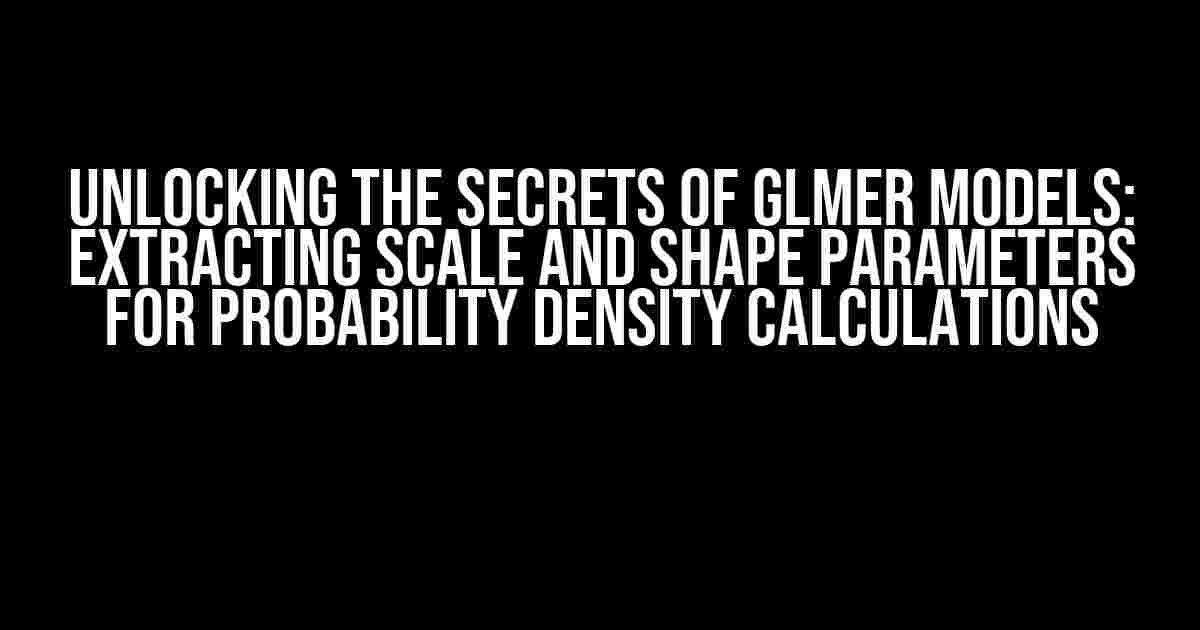Are you struggling to extract the scale and shape parameters of your Gamma-distribution GLMER model to calculate probability densities for unseen data? Fear not, dear reader, for this article is here to guide you through the process with ease and clarity.
What are GLMER Models?
Generalized Linear Mixed Effects (GLMER) models are a powerful tool for analyzing complex data structures. They extend traditional linear models by allowing for non-normal responses, non-linear relationships, and random effects. In the context of Gamma-distribution, GLMER models are particularly useful for modeling continuous, positive outcomes with right-skewed distributions.
Why Extract Scale and Shape Parameters?
The scale and shape parameters of a Gamma-distribution GLMER model are crucial for calculating probability densities of unseen data. These parameters determine the shape and spread of the Gamma distribution, which in turn affect the predicted probabilities. By extracting these parameters, you can:
- Estimate the probability of new, unseen data points
- Generate predictions with confidence intervals
- Visualize the distribution of predicted values
- Perform hypothesis testing and model evaluation
Step-by-Step Guide to Extracting Scale and Shape Parameters
Let’s dive into the steps to extract the scale and shape parameters of your Gamma-distribution GLMER model. We’ll use the `R` programming language and the `lme4` package for illustrations.
Assuming you have a GLMER model fitted to your data, the first step is to extract the model summary:
library(lme4)
model_summary <- summary(model)
The `model_summary` object contains the estimated model parameters, including the scale and shape parameters of the Gamma distribution.
Extracting the Scale Parameter
The scale parameter of the Gamma distribution is denoted by σ (sigma) and represents the spread of the distribution. To extract the scale parameter, use the following code:
scale_parameter <- model_summary$sigma
The `scale_parameter` object now holds the estimated scale parameter of your Gamma-distribution GLMER model.
Extracting the Shape Parameter
The shape parameter of the Gamma distribution is denoted by k (kappa) and determines the shape of the distribution. To extract the shape parameter, use the following code:
shape_parameter <- model_summary$var-components[[1]]["k"]
The `shape_parameter` object now holds the estimated shape parameter of your Gamma-distribution GLMER model.
Calculating Probability Densities for Unseen Data
Now that you have extracted the scale and shape parameters, you can calculate the probability density of unseen data points using the `dgamma` function in `R`:
new_data <- data.frame(x = c(1, 2, 3, 4, 5))
new_data$prob_density <- dgamma(new_data$x, shape = shape_parameter, scale = scale_parameter)
The `new_data` dataframe now contains the calculated probability densities for each unseen data point.
Visualizing the Results
To visualize the results, you can create a density plot of the predicted probabilities using the `ggplot2` package:
library(ggplot2)
ggplot(new_data, aes(x = x, y = prob_density)) +
geom_line() +
labs(x = "Unseen Data", y = "Probability Density")
This will generate a density plot showing the predicted probabilities for each unseen data point.
Common Issues and Troubleshooting
When working with GLMER models and extracting scale and shape parameters, you may encounter some common issues:
-
Convergence issues: If the model doesn’t converge, try adjusting the optimization algorithm or increasing the number of iterations.
-
Non-positive values: Ensure that the response variable is strictly positive, as Gamma-distribution GLMER models assume positive outcomes.
-
Model misspecification: Verify that the Gamma distribution is appropriate for your data and that the model is correctly specified.
Conclusion
Extracting the scale and shape parameters of a Gamma-distribution GLMER model is a crucial step in calculating probability densities for unseen data. By following the steps outlined in this article, you can unlock the full potential of your model and make accurate predictions. Remember to troubleshoot common issues and verify the assumptions of your model to ensure reliable results.
With this knowledge, you’re now equipped to tackle complex data analysis tasks with confidence. Happy modeling!
| Parameter | Description |
|---|---|
| Scale (σ) | Represents the spread of the Gamma distribution |
| Shape (k) | Determines the shape of the Gamma distribution |
Bookmark this article for future reference and share your experiences with extracting scale and shape parameters in the comments below!
Frequently Asked Question
Get ready to dive into the world of Gamma-distribution GLMER models and unleash the power of extracting scale and shape parameters to calculate probability densities of unseen data!
What is a Gamma-distribution GLMER model, and why do I need to extract its scale and shape parameters?
A Gamma-distribution GLMER (Generalized Linear Mixed Effects Regression) model is a statistical model that combines the benefits of generalized linear models and mixed effects models. It’s commonly used to analyze continuous outcomes with positive skewness and heterogeneous variance. Extracting the scale and shape parameters of the Gamma distribution is crucial because they determine the shape and spread of the distribution, allowing you to calculate the probability densities of unseen data.
How do I extract the scale and shape parameters from a Gamma-distribution GLMER model?
You can extract the scale and shape parameters from a Gamma-distribution GLMER model using the coefficient estimates and variance components obtained from the model. Specifically, the scale parameter is typically represented as the inverse of the dispersion parameter, while the shape parameter is derived from the variance components. You can use software packages like R or Python with libraries like lme4 or scikit-learn to fit the model and extract the desired parameters.
What is the significance of the scale and shape parameters in calculating probability densities of unseen data?
The scale and shape parameters play a critical role in determining the probability density function (PDF) of the Gamma distribution. The scale parameter controls the spread of the distribution, while the shape parameter influences the skewness and kurtosis. By using the extracted scale and shape parameters, you can calculate the PDF of the Gamma distribution, which allows you to obtain the probability densities of unseen data. This is essential for making predictions, estimating uncertainty, and performing hypothesis testing.
Can I use the extracted scale and shape parameters to calculate other statistics, such as mean and variance?
Yes, you can use the extracted scale and shape parameters to calculate other statistics, such as the mean, variance, and higher moments of the Gamma distribution. The mean and variance of the Gamma distribution are functions of the scale and shape parameters, specifically, the mean is the product of the scale and shape parameters, and the variance is the product of the scale squared and shape parameter. This allows you to perform further statistical analyses and modeling tasks.
Are there any assumptions or limitations I should be aware of when extracting and using the scale and shape parameters of a Gamma-distribution GLMER model?
Yes, there are several assumptions and limitations to be aware of when working with Gamma-distribution GLMER models and extracting the scale and shape parameters. For example, the model assumes that the response variable follows a Gamma distribution, and the residuals should be Gamma-distributed as well. Additionally, the model parameters should be estimated accurately, and the variance components should be properly specified. It’s essential to check the model assumptions, evaluate the model fit, and consider alternative models if necessary to ensure reliable results.


